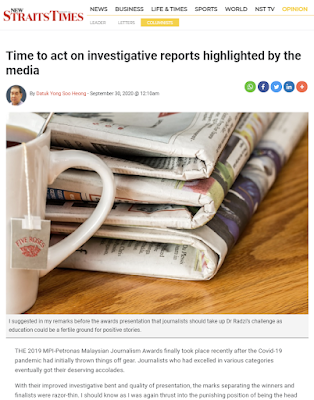 |
| Republished from New Straits Times, Sept 30, 2020, with the author’s permission. Read the original here. |
THE 2019 MPI-Petronas Malaysian Journalism Awards finally took place recently after the Covid-19 pandemic had initially thrown things off gear. Journalists who had excelled in various categories eventually got their deserving accolades.
With their improved investigative bent and quality of presentation, the marks separating the winners and finalists were razor-thin. I should know as I was again thrust into the punishing position of being the head of the judging panel! As with many award-winning entries of the recent past, many tend to focus on lax enforcement, mismanagement, corruption and red tape in government. The propensity for in-depth unearthing of such misdeeds was not lost on the guest-of-honour, Senior Education Minister Dr Radzi Jidin, who represented Prime Minister Tan Sri Muhyiddin Yassin at the function.
While urging journalists to uphold journalism’s core values of integrity, authenticity and relevance, Dr Radzi asked — could they turn their attention on positive matters for a change? I suggested in my remarks before the awards presentation that journalists should take up Dr Radzi’s challenge as education could be a fertile ground for positive stories.
While many jaded people would be quick to throw cold water on this much-debated subject, I believe that good education-related materials exist to be unearthed while not forgetting the not-so-good ones as well. On a positive note, one of the winning entries revealed that many urban poor students tend to experience more mental health issues and there was a need for more counsellors in schools!
Education-related matters need further probing to bring to light what needs to be done to provide the best for our leaders and talent of tomorrow. After all, Malcolm X, a Muslim African-American civil rights leader, had reminded us that “Education is the passport to the future, for tomorrow belongs to those who prepare for it today.”
In my view, news organisations don’t go pursuing bad happenings for them to be sensationalised. These news items are for real, had taken place and warranted attention so that action can be taken for the benefit of the people. Media organisations play a central role in recording events and promoting greater awareness about pertinent issues that affect our lives day in and day out as today's news will stand as historical facts for the future.
Having said that, we cannot help noticing some of the unsavoury things that had been highlighted. Like the heart-wrenching tales of illegal migrants being smuggled into the country and forced to live like animals in the forests before they are “safely” transported were rife.
Not only humans were trafficked, animals too, such as the prized pangolins, rumoured to have medicinal powers for pregnant women to lactate even more! Stories about our rivers and reservoirs being polluted were aplenty. And how the health of young schoolchildren was affected by the now infamous Sungai Kim Kim and other filthy rivers in Johor. Or the frequent encroachment into our rich marine waters by foreign fishermen or villagers being exposed to unhealthy levels of lead pollution from processing industrial wastes dumped by developed countries.
I was also attracted to the New Straits Times’ focus on the daily grind of thousands of commuters at the Johor Baru Causeway, either going to work or study in Singapore. These early risers are doing just that because they want bring to a little more food to the table or to have better employment prospects later on. It’s a crying shame that our people have to endure deplorable conditions each morning.
Now that the Causeway is not as crowded as before because of the Recovery Movement Control Order, perhaps the authorities could do something there fast. Strike while the iron is hot. Democratic governments change because of shifts in voting patterns of voters or in political colours of politicians. But there's little change in the government machinery or personnel.
It would do the rakyat a lot of good if these investigative reports were seriously evaluated by heads of relevant departments and acted upon immediately. After all, our current government's tagline is “Kita Jaga Kita” and William Shakespeare did say: “It is not in the stars to hold our destiny but in ourselves.”
- Datuk Yong Soo Heong is a former chief executive officer and editor-in-chief of Bernama. Read more about him here.
